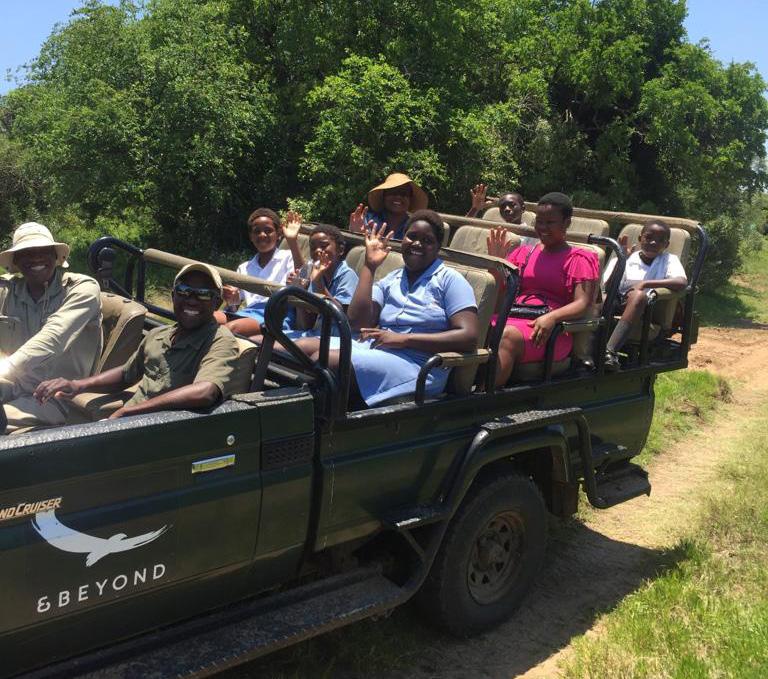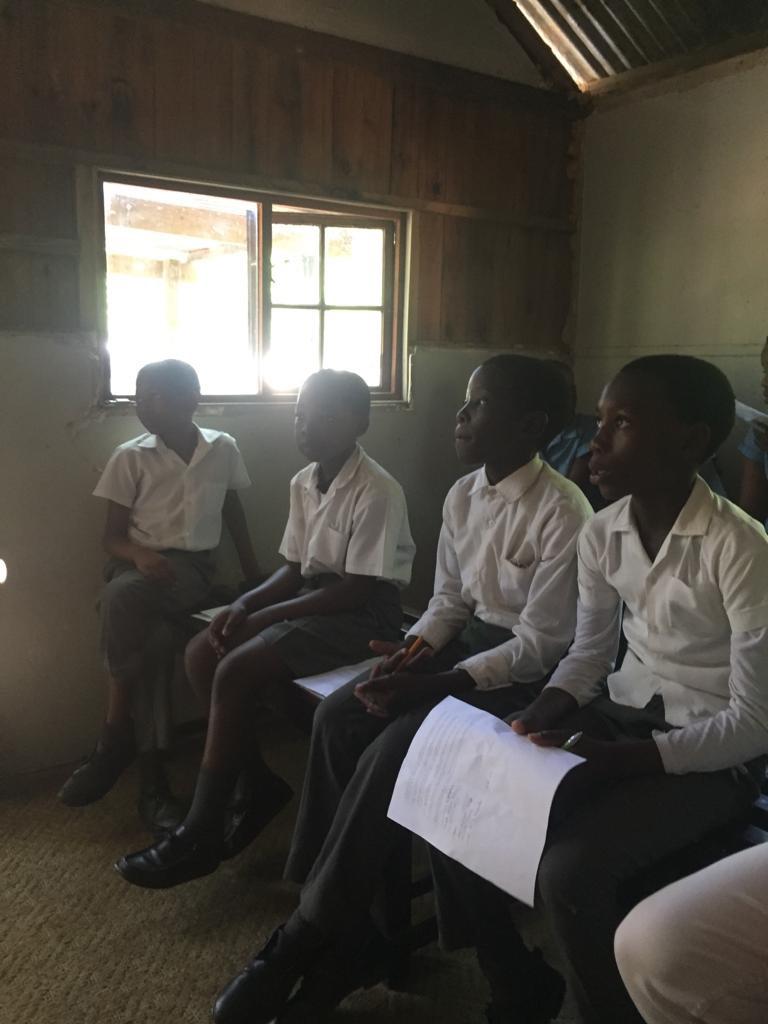
7 minute read
African Tourism; GAME DRIVE TO TRANSFORM the CONTINENT
By Peter Burdin
Even though she grew up next to one of Africa’s most prestigious game reserves, nineyear-old Neliswa had never seen an elephant. Now thanks to a conservation education programme aimed at empowering some of Africa’s rural communities she’s becoming an expert on the continent’s rich natural history. Under the expert eye of former game ranger Kulu Benson Neliswa and her classmates are given free game drives into local reserves around South Africa’s famous Kruger Park to observe and learn about African wildlife. Thanks to the Africa Foundation’s Environmental Education Programme known as ECHO more than a thousand school children have taken part in the game drive conservation lessons, and have benefitted from the knowledge of experienced Rangers like Kulu Benson who’ve spent their lives in the African bush studying animal behaviour. Some 64 Primary schools and 36 secondary schools are taking part in the programme in South Africa, while 9 primary and 5 secondary schools in East Africa also participate. The

Foundation’s aim is to educate a new generation of African school children to the beauty that surrounds them and the importance of conservation. Thanks to support from the leading conservation and tourism company &Beyond and the South African bank Nedbank’s Yes4Youth initiative a network of 287 young stewards or teaching assistants have been deployed into classrooms to deliver environmental lessons. Almost three-quarters of the stewards are young women. Their work demonstrates that in a country with high unemployment there is a vast untapped talent pool in South Africa ready and able to support the school-children.
According to high school teacher
Kutshemba Ingrid Khoza the programmes makes a real difference: “The stewards that are placed in our school are working very hard to make the learners love their environment.
“It means that despite the fact that we are from a rural area, we deliver quality education. Our learners are learning a lot about nature conservation. They are given time for game drives, they plant trees and flowers in the school and make sure they look after them.”

Likewise ten-year old learner Charity Mathebula to enjoying the young stewards’ lessons:
“I’m excited to be taught by someone who is younger, who explains lessons in a fun manner that is not easy to forget.”
Charity liked the fact that audiovisual displays are included as part of the learning experience: “Thank you to someone who made it possible for us to be given a projector so we can learn about animals that we can see”. The projectors enable the children to see
Africa’s vast range of wildlife which many have not been able to see at first-hand. The children are also provided with workbooks which teach them a range of subjects about the habitats of plants and animals. They learn about the importance of forests for the growth of continent’s indigenous trees and plants, and they learn about Africa’s grasslands and great plains where the big cats like lions, leopards and cheetahs live, and where all kinds of antelopes, zebras, and wildebeests roam. Clearly though the highlight of the teaching has to be the game drives of Kulu Benson and his team of Rangers. These give the children hands-on experience to observe the animals at close quarters. They learn to appreciate the beauty of their continent and, crucially, learn how important it is to protect and nurture it. In East Africa the Foundation employs 8 male rangers and a female ranger. And, according to 12-year-old Arafa Makumbi Juma, their impact has been massive: “Before we learned a little concerning environmental conservation but now we know about coral restoration, fish, turtles, dolphins and how to conserve our environment” Her contemporary Ali says the environmental teaching has encouraged him to be a conservationist when he grows up: “I’ve learned about the environment, how it benefits us and marine environments and corals. I’ve learned the importance of coral restoration. I want to share the lessons I learned about protecting corals with my community because it brings tourism. In future I can be a local beach boy and boat captain.” In Zanzibar the Africa Foundation is actually restoring the local coral reef which has been largely destroyed by a surfeit of tourist cruise ships and over-enthusiastic divers and snorkelling. The work to grow new coral demonstrates how damaged ecosystems can be restored to their former glory. There’s also a massive tree planting programme in Kenya’s Nyakweri Forest which aims to plant 20,000 seedings a year. This provides a learning opportunity for the local school-children. Through nurturing these young saplings in a tree nursery they learn about the conservation importance of the Forest and the extended Masai Mara conservation area nearby. In the words of the Africa Foundation’s mission statement it is “Empowering communities and enabling conversation”. The Foundation hopes that its Environmental Education Programme will provide the continent’s young people with a greater knowledge and understanding of the importance of nature to the life and wellbeing of the continent. It’s important work especially in the age of climate change that is bringing drought, floods and devastation to so many of Africa’s ecosystems. This climate emergency strikes at the heart of Africa’s fragile ecosystems and is a theme at the core of the African Development Bank’s mission to seek to mitigate the impact of climate change across the continent. More than half of the Bank’s expenditure is now devoted to climate adaptation. . It estimates that it will cost Africa more than $ 7 billion a year to combat this climate emergency and that Africa’s poorest and most vulnerable countries will require at least $500 billion to tackle climate change. This existential battle will be high on the agenda of the Bank’s Annual meetings later this month in Egypt. The UN SecretaryGeneral has already warned that the world is already on “Code Red” in response to the latest Intergovernmental Panel on Climate Change Report. In Africa we might already be beyond “Code Red.” The Bank has already committed $13 billion in climate finance to transform its impact. The theme of the Bank’s Annual Meetings last year was “Achieving Climate Resilience and a Just Energy Transition for Africa”. It sought urgent solutions to these two massive challenges. As the Bank’s President Dr Adesina argued:


“We owe it to our people living in the most vulnerable parts of the continent, those who are already experiencing extreme heat, droughts, floods and food insecurity, and those millions still without electricity. That’s why we will mobilise 25 billion dollars by 2025 to make our Desert To Power a reality in the Sahel”.
He also singled out the Great Green Wall project to plant millions of trees across Africa from west to east as a key element in plans to create a greener and more sustainable future for millions of Africans.
Building climate resilience isn’t only about conservation, it’s also about better use of the land food security in a continent about to double the size of its population in the next generation. That’s why the Bank has rolled out a 1.5 billion dollar plan to boost wheat production by 11 million metric runs. It also boosted the production of staples like maize, rice and soybeans. Likewise to meet the threat of farmers losing access to vital fertilizers it deployed its Africa Fertilizer Finance Facility to help countries boost crop production. The Bank has also supported millions of African farmers, the majority of them women, by funding the development of climate resistant seeds which can thrive at higher temperatures while increasing yields. This is designed to make Africans across the continent more resilient to the ravages of climate change while paving the way to Africa’s resurgence. That’s why teaching the rising generation of African children the importance of the environment is so crucial. They are already entering a world where through no fault of their own they will have to live with rising temperatures and all the devastation that will bring to their lives and livelihoods. The more they can be taught about the world that surrounds them the better. They need to know the importance of forests and grasslands to protecting their environment because without well husbanded and well protected forests and grasslands temperatures will rise even higher. They also need to learn the importance of Africa’s so-called blue economy and the fact that healthy rivers and oceans need to be preserved and not polluted or over fished. The work of the Foundation aims to give as many African children as possible a deeper awareness of what’s at stake and why it is so important for them to learn to protect and conserve the continent’s natural habitats. That’s why at secondary school level the ECHO programme includes courses on the importance of energy and photosynthsies; the symbiotic relationship between elephants and marula trees; the cost of damaged and inbalanced ecosystems as demonstrated by the impact of El Nino, man-made fires and poaching; and the importance of recycling for the conservation of Africa’s limited water supplies. As one steward put it: “We need to learn more about the importance of conserving and preserving our environment as well as our resources for future generations”. At its most basic level the programme enables young children like Neliswa who’d never seen an elephant before to develop a desire to understand the beauty of the environment around her. However it also has a much broader mission – to give her and her generation the tools to save Africa from the worst revages of the climate emergency. As one of the children’s teaching assistants Leean Ayanda Mathebula explained the programme has also given her a new appreciation of the environment along with a job and a new career: “I have learned a lot. I never thought teaching is a good career until I fell in love with my job as a Steward, and that has given me a chance to go after teaching studies. I’ve also learned a lot about how to take a good care about our environment and the importance of all the natural resources and things we have. And the importance of the career that we never thought about as environment teachers”. Leean and her teaching assistant colleagues are now working in 64 primary schools and 32 secondary schools around the Kruger. In addition to delivering environmental lessons, they support community clean-up activities and supervise the planting of food and indigenous trees. Together they have taught almost 40,000 children. The vision of the Africa Foundation and its &Beyond partners is threefold – care of the people, care of the wildlife and care of the land. In its own words: “To leave our world a better place” It would seem they’ve made a pretty good start.












